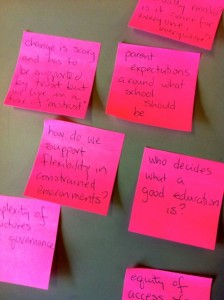Education
Reflecting on the Post-Appeal Landscape
This is not an article about denying any person or organization the right to due legal process.
Why do I feel it necessary to start off with such a sentence?
Because I’m familiar with the way in which posted opinion pieces are picked apart in the frenzied hot-house atmosphere of social media and what I’m about to say will likely be open to simplistic misinterpretation.
Before I explain and as I’ve done in previous articles, I’d like to note that any errors of fact in the following discussion are my own as are the views expressed here: these are not the views of the West Vancouver Board of Education. I’d also like to clearly acknowledge that this is not a legal opinion.
Starting in 10 days’ time, the BC government and the BC Teachers’ Federation (BCTF) will once again be in court, this time at the BC Court of Appeal addressing the government’s appeal and stay which were both granted in response to the Griffin decision released earlier this year.
The case hinges on what Justice Griffin deemed to be the unconstitutional removal of clauses from the collective agreement relating to class size, class composition, and the ratio of specialist teachers.
I’m not going to dwell on the intricacies of labour law, on the history of the case, or on the relative merits of each sides’ arguments.
What I want to touch on is what may happen after the appeal.
Why?
Because it’s time to get public education in BC out of the courts and back into the classrooms and I’m concerned about the post-Appeal landscape in terms of the potential for continuing legal proceedings.
An article by Ian Mulgrew of The Vancouver Sun prompted me to reflect and write on this issue. In his piece, Mr. Mulgrew explains a recent Supreme Court decision which declared that the fees BC charges for court hearings are unconstitutional. The court ruled that these fees in effect prevented individuals from unfettered access to the legal system in their pursuit of justice.
So what’s the connection to the pending appeal of the Griffin decision?
To me, it’s this. We know the Supreme Court of Canada is the highest court in the land and we know it remains as the ultimate arbiter especially in regard to Charter issues. Applying to the Supreme Court of Canada with regard to a judgement ought not to be taken lightly and only with due regard to the consequences its decisions may have on governance and policy.
There has been much speculation that no matter who wins the appeal this October, the next step is bound to be the Supreme Court because the issues raised in the Griffin decision go to the very heart of collective bargaining rights.
But does it automatically follow that it is the right course of action in this situation?
Specifically, if the government loses the appeal would it be smarter to honour the spirit of the Griffin judgement and negotiate class size and composition rather than taking the matter to the Supreme Court of Canada and risking an outcome which could have a significant impact on all public sector agreements?
Similarly, if the government wins the appeal would it be smarter for the BCTF to honour the spirit of the Griffin judgment and negotiate class size and composition rather than taking the matter to the Supreme Court of Canada and risking an outcome which may actually relieve the government of an obligation to significantly reinvest in the BC public education system?
I know that lawyers for both sides will have very compelling reasons for their clients to continue to pursue the case all the way to Ottawa. Why not? It’s a legal challenge and becomes part of one’s legal legacy let alone precedence as law of the land.
However, is it valid to say just because you can doesn’t mean you have to? And while the outcome of the case on court hearing fees is a victory for citizens, I think the case regarding the BCTF collective agreement is even more complex and nuanced which makes the risk, in my opinion, greater.
And while I’m proud of our legal system and would always support due process, I’m not convinced — yet — that extending this particular legal imbroglio all the way to the highest court will be in the best interest of our students.
What Is The Purpose of Education?
It was a very interesting day to hear Susan Lambert speak.
It was the day teachers throughout British Columbia were voting on whether or not to ratify a new collective agreement, one which fell short of expectations and which merely represented the achievable at this moment in time.
While it was a difficult deal for educators to accept, one of the most important achievements for the BC Teacher’s Federation (BCTF) in the new agreement was the preservation of the integrity of their court case on class size and composition.
And Susan Lambert, who had other reasons for looking askance at the proposed agreement, knows how critically important that court case is for the future of public education in BC.
For those who may not know, Susan Lambert is the past president of the BCTF and a long time educator having started her teaching career in 1973/1974. She is also an alumna of the Faculty of Education at Simon Fraser University (SFU).
And that’s how I happened to be in the audience to hear her speak. She was addressing an education class at SFU, a class in which my nephew is enrolled.
Yes, I have a nephew who is currently pursuing an undergraduate degree at SFU and whose long-term plan is to become an educator.
I not only support his choice, I celebrate it because no matter the hardship and the challenge, being a teacher, in my view, remains one of the most fundamentally important roles in society.
My nephew’s professor had invited Ms. Lambert to address his students and had told them guests were welcome. When my nephew extended the invitation, I jumped at it: this was not an opportunity I was going to miss.
Why?
Because while I may not agree with Ms. Lambert on any number of issues, she is a passionate advocate for public education. Not only that, but she is a firm believer in making the world a better place, particularly for those who are most disadvantaged in our economic system.
She is also someone worth listening to because of her experience in BC’s public education system and because of her commitment to advocacy.
At the beginning of her presentation, Ms. Lambert challenged the students to consider what their purpose was in becoming educators. In other words, she wanted them to consider why it was they wanted to teach. She asked them to consider the question because, as with any vocation or endeavour which we undertake, it is the meaning in what we do and the intent with which we do it that makes our choices purposeful and rewarding in good times and in bad.
I think this is particularly true in a profession such as teaching which is based on relationships and where doing one’s best is instrumental in helping others to achieve theirs.
As much as I appreciated Ms. Lambert’s challenge to the students, it was her summary of the purpose of education which crystallized why the fight for public education in British Columbia is so critical.
And it is simply this: a thriving and vibrant public education system is the essential ingredient for a civil society.
A just society.
An equitable society.
What greater purpose could there be but to work on behalf of a system which is the foundation to a better future for all citizens and not only those who can afford it?
When Is One Reopening Clause Better Than Another?
Today will be a historic day in BC public education. Members of the BC Teachers’ Federation (BCTF) will be voting on whether or not to ratify the tentative agreement their union hammered out with the BC Public School Employers’ Association (BCPSEA) earlier this week.
As of about 9:00 p.m. Wednesday evening, the BCTF had shared summary information with its members and conducted information sessions on the tentative agreement although they had not yet released the full text of the proposed contract.
While the BCTF executive and bargaining team have maintained that the tentative agreement does not infringe on the court case regarding class size and composition, there are those who dispute their assertions particularly with regard to what’s being called the “reopening” provision.
Not only do I believe that the BCTF is correct in saying that the reopening provision does not hamper the court case, but I see it as a “give” on the part of BCPSEA and the government.
Why?
Before I explain and as I’ve done in previous articles, I’d like to note that any errors of fact in the following discussion are my own as are the views expressed here: these are not the views of the West Vancouver Board of Education. I’d also like to clearly acknowledge that this is not a legal opinion.
While I haven’t seen the final text of the reopening provision, this summary represents my analysis based on the preliminary information I’ve received from two different sources.
According to what I know, if the government wins the appeal, the collective agreement will remain in place until the end of the term which will be June 2019. During that time, if the BCTF has lost the appeal, it may try to refer the decision to the Supreme Court of Canada (SCoC) (which may or may not grant leave to hear the case), but in the time it may take for such action, teachers will be at work and students will be in school.
If you remember, this is significantly different from BCPSEA’s original E81 proposal which would have allowed reopening of the collective agreement by either party following the appeal decision. Due to intense public pressure, this clause was dropped by BCPSEA during bargaining.
So if the government wins the appeal — which may mean that the class size and composition language would not be restored to the collective agreement — the contract would not be affected. I say “may” because we don’t know if the appeal will address all of the Griffin judgement or only parts of it. There’s no way of saying with absolute certainty what a government win would look like.
On the other hand, if BCTF wins at the Court of Appeal, then the collective agreement may be opened for discussion by the parties. The draft language I’ve seen seems to indicate that the collective agreement would only be opened on this issue. If this holds true in the final text of the proposed clause, it is significant because it means the talks which would result from any reopening would only contend with class size and composition and not any of the other terms or provisions. That means wages, benefits, prep time, and the changes regarding TTOCs agreed to in this round of bargaining would all be protected.
Faced by a BCTF win at the Court of Appeal, which many presume is likely but which is not a predetermined nor a guaranteed outcome, the government may choose to petition the SCoC. I’m not clear yet on what that means with regard to negotiations on class size and composition. That is, if the government appeals to the SCoC, will the parties still open that part of the collective agreement even though the court process has not been completed or will they wait until such time as the SCoC, if it agrees to hear the case, makes its final determination?
Nonetheless, the current deal, if ratified, would remain in place until such time as changes regarding the restored language around class size and composition was agreed to and implemented. If I’m understanding this correctly and if the court decision comes down sometime before June 2019, the talks on class size and composition could take place without a strike or lockout which would only be options available when the contract does expire.
Looked at in this way, it seems to me that this reopening clause is a vast improvement, from the perspective of the BCTF, over what had been proposed by BCPSEA in E81.
With regard to the view that the reopening clause imperils the court case, it seems to me this opposition is based on an interpretation which is not aligned with the Griffin judgement nor in the spirit of it.
This discrepancy is at the heart of the legal conundrum and which will only be clarified by the upcoming rulings at the BC Court of Appeal and the SCoC if this case goes that far.
The conundrum is this: in the face of a lack of agreement on class size and composition, once and if the collective agreement is reopened for bargaining, which language carries forward into future contracts?
The assumption by many BCTF members seems to be that in such an eventuality the 2002 language, as it was and in full, would carry forward with fixed limits on class size, a fixed cap on class composition, and fixed ratios for specialist teachers.
I’m not sure that’s a valid assumption because it seems to me Justice Griffin restored the language to the historic contract with a clear admonition that it would likely change through collective bargaining.
But, what did Justice Griffin mean by change? Does change mean the same language, different numbers? Different language, same numbers? Different language, no numbers? How large a scope does collective bargaining have when it comes to new language in a contract for pre-existing provisions?
There’s another piece of the puzzle to consider. If the class size and composition provisions had remained in the 2002 collective agreement, the parties would have potentially negotiated at least two or three or more collective agreements since then. I think it’s reasonable to assume that the language of those hypothetical agreements may have looked different from 2002 (especially when you consider the unconstitutional measures the government took to remove those sections from the contract). As much as we might conjecture, we can’t say with certainty what the modified language would have looked like.
Although we don’t know what a consistently negotiated contract may have looked like, it seems to me that in the face of a lack of agreement now, the language of the most recent agreement — the agreement we can imagine but which never existed — would be the language to go forward NOT the historically restored language from 2002. And, that’s why there’s room in this particular case to consider significantly new language for class size and composition albeit it is new language which the two parties will have to agree upon through a process of good-faith collective bargaining.
Because the puzzle of what happens in the absence of an agreement remains unsolved, I’ve come to understand much better why the most reasonable approach in this situation has to be “let the courts decide” and the only path to a negotiated settlement, at this time, was a “work around”.
The need to let the courts decide is clearly one of the factors which has made this round of bargaining so difficult.
It’s also why I believe that the proposed reopening clause works in favour of the BCTF and its members because it seems to provide a way to discuss the most critical issue in the collective agreement without any further labour disruption to the public education system until June 2019.
And I can’t help but feel that’s a good thing.
The Trouble With Our Schools Is Not ESL
In his English 104 lecture today at Simon Fraser University (SFU), Dr. Paul Matthew St. Pierre argued that our posts, tweets, texts, online articles, and other written forms of expression in the digital sphere are published works.
By publishing via these new media forms, we become authors and contributors to digital culture. I, for one, am grateful that technology has made this access to publication possible. In almost three years of writing for my blog, I’ve been able to put forward opinions on a range of topics for consideration.
However, by publishing on my blog, I’m certain readers know the content of each article represents my own personal opinion albeit informed by my experience, my work, my position, and my reflections on what I may have read, seen, and heard.
In contrast, opinion pieces published in traditional mainstream media publications, such as The Vancouver Sun, are imbued with the aura of a journalistic standard even when they too are statements of personal opinion. Even when marked with the label “Opinion”, as with today’s column by Shelley Fralic, this apparent legitimized authority can be problematic.
Why?
Simply put, because today’s contribution on the public education system by Ms. Fralic was poppycock.
The trouble with our schools is not spelled ESL as Ms. Fralic contends. Rather than spotting an elephant in the room, she has spotted a mouse and while focused on the “wee … tim’rous beastie,” running across the room to escape, she’s missed the herd of elephants standing right behind her.
It is true that the number of English Language Learners (ELL, previously ESL) is rising in our classrooms, particularly in the Metro Vancouver area. And it is true that more ELL students has contributed to greater complexities in terms of class composition. But does Ms. Fralic — or anyone else for that matter — really believe that removing ELL students from our classrooms would somehow magically eliminate the issues we face?
It’s preposterous because the problem with our schools — the real elephant in the room — is the slow steady erosion of government support which has seen, based on court estimates, approximately $300 million per year kept out of the public education system. That’s money which would have provided programs, resources, and services to all students including the help of specialist teachers.
And here’s the thing: the students who need the help of those specialists may be ELL students, and often they are not. Students arriving for kindergarten without adequate pre-literacy skills may be ELL students, and often they are not. The truth is obstacles to learning, whether speech impediments, learning disabilities, behavioural issues, or other, are not specific to any one culture or any one language.
Neither is poverty.
Neither is economic inequality.
And these are among the real obstacles to better functioning classrooms along with the lack of adequate community resources for all families, whether new to this country or not.
The reality is — as I witnessed in the school my child attended last year — a large number of ELL students introduces an amazing level of diversity into a school community. The learning opportunities, with the exposure to a variety of cultures, are magnified. And the emphasis on inclusion introduces a depth of acceptance that is unparalleled.
That’s how we build understanding. That’s how we build a society. That’s how we build tolerance.
ELL students are the ones who will emerge from our public education system fluent in more than one language: an invaluable asset in our globalized world.
And, their multi-lingual, multi-cultural sensibility is one they will put to good use in making their contributions to Canada and to Canadian culture.
So You’re a TA, eh?
I’m very pleased to be back at Simon Fraser University (SFU) this term as a Teaching Assistant (TA) with the Department of English. I am leading two tutorial sections for English 104W – “Introduction to Prose Genres: Digital Perspectives on Canada’s Media History and Messaging as a Prose Genre” with Dr. Paul Matthew St. Pierre.
For those of you who follow me on Twitter or on Facebook, you may guess why I’m particularly excited about being a part of this course. Given how much time I currently spend on social media, the course is a way to consider my online practice in a historical and cultural context.
I anticipate that the course content will support what I’m doing, it’ll challenge what I think, and it’ll motivate me to ensure my social media activities are pursued in an even more thoughtful manner. With three lectures done already, I foresee that Dr. St. Pierre may be setting the stage for us to consider our time on social media as “work” within the digital sphere and electronic devices as the tools by which we complete that work.
To think of my time online as work adds a whole new dimension to my role as a digital citizen.
Aside from grounding my social media use in this context, I’m really excited about having the opportunity to work with undergraduate students again.
Why?
It’s not because of the marking, which is likely my least favourite aspect of the job, although assessment is important in the university environment.
It’s not for the office I get to use since it’s remarkable how infrequently students stop by to visit.
It’s not for the authority which the position bestows upon me although it’s wonderful to be able to think about the tutorial sessions as “my classes” and those enrolled as “my students”.
It’s because as I work with the students I feel — I hope — I’m making a contribution to their learning. From exhorting them to look up words in a dictionary, to pushing them to care about writing, to asking them to see beyond the words on the page (or on the screen), I’m trying to show them that they have agency in this world.
I want them to know that their agency will be based on their ability to read, reflect, think, challenge, analyze, and communicate. It doesn’t matter what their career aspirations may be, it doesn’t matter which field of work they intend to pursue, it doesn’t matter what subjects they may wish to study, these are the abilities which will serve them well in any career, in any field, in any subject area.
That is, I want them to value learning, I want them to value thinking, and I want them to know that the ability to fully realize their potential depends on their ability to focus on more than just their grades and to look beyond the message no matter the form.
And in working with them, I recognize that I value my work as a TA because it allows me to do the same with regard to my own agency.
It allows me to recognize the following:
- I’m not so much a person who accepts as I am someone who questions.
- I’m not so much a teacher as I am a student.
- I’m not so much a person who imparts knowledge as I am a learner.
For life.




